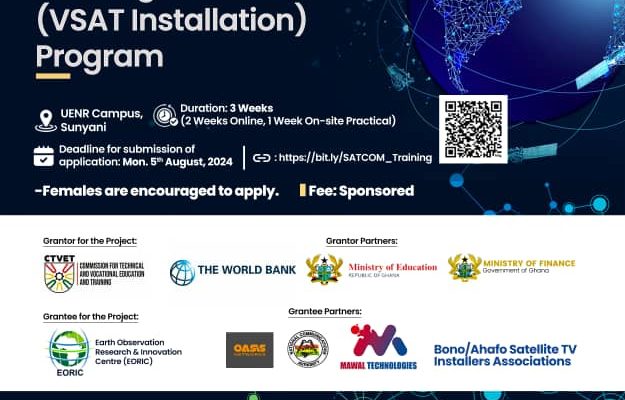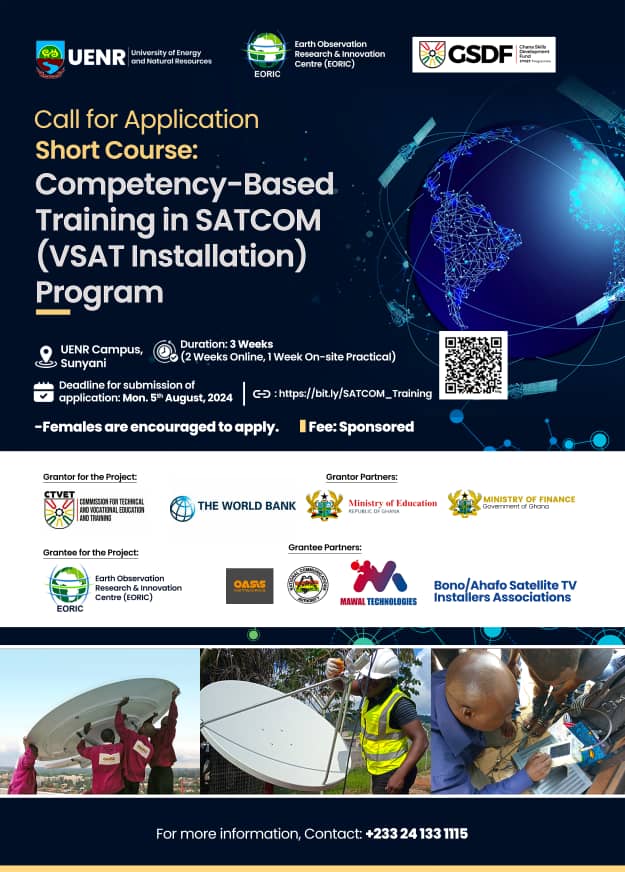SHORT COURSE: COMPETENCY-BASED TRAINING IN SATCOM (VSAT INSTALLATION) PROGRAM - EORIC
- Home
- Training Programmes
- SHORT COURSE: COMPETENCY-BASED TRAINING IN SATCOM (VSAT INSTALLATION) PROGRAM

- 0 Comments
- eoric_admin
- July 22, 2024
1. Introduction
The Earth Observation Research and Innovation Centre (EORIC) at the University of Energy and Natural Resources has received a grant from the Ghana Skills Development Fund (GSDF) under the Commission for Technical and Vocational Education and Training (CTVET). This funding will establish a comprehensive Professional Satellite Communications (SATCOM) Certification Course. The main goal is to provide engineers, technicians, and entrepreneurs with the necessary knowledge and skills to thrive in the rapidly evolving SATCOM and telecommunications sector. The next phase involves training approximately twenty (20) individuals after developing the Professional SATCOM Certification Course curriculum and setting up the SATCOM Training Hub. Applications for the SATCOM (VSAT Installation) Program are open to Ghanaians working or aspiring to work in the SATCOM and telecom industry as engineers, technicians, and entrepreneurs.
2. Background
Skilled Fixed-antenna VSAT field technicians and engineers are crucial in achieving precise antenna alignment. This task is fundamental to the peak performance of Very Small Aperture Terminal (VSAT) systems. Their advanced expertise is essential in identifying and preventing primary sources of uplink interference, ensuring robust and reliable communication links. Recognising their importance in the process can instill a sense of value and significance in their roles.
3. Lessons Content
Theory Session:
- Introduction to Satellite Communication: This lesson comprehensively explores the technology and business landscape of satellite communications, ensuring a thorough understanding for the technicians and engineers.
- Very Small Aperture Terminal (VSAT): This lesson includes an overview of the essential components present in all satellite terminals. It also covers cables and connectors, featuring step-by-step instructions on cable preparation, crimp, compression connector attachment, and a simulator skills test.
- Site Selection for VSAT Installation: This lesson features interactive 3-D animations of latitude, longitude, and satellite orbits, as well as an interactive 3-D line-of-sight simulator. These elements are designed to actively involve the technicians in their learning process, fostering a sense of engagement and participation.
- Polarization theory: With a 3-D animation of polarisation angles and interactive exercises in pre-setting feed rotation.
- Building the terminal and finding the satellite: With tutorials on techniques for rapidly finding the correct satellite, practice on a full 3-D interactive VSAT antenna simulator with a working signal meter.
- Accurate pointing: This lesson includes tutorials and 3-D simulator practice of the beam balance method for preventing adjacent satellite interference, and a start-to-finish simulator for practice and skills tests.
- Cross-pol alignment and activation: This lesson includes calculating uplink IF frequencies and working with the satellite access centre to perform a cross-pol alignment. Includes interactive cross-pol line-up exercise and skills test.
- Decommissioning: Correctly decommission a VSAT to prevent it from making interference
Practical Session
- Installation, Commissioning, and Activation of YahClick Ka-Band VSAT system.
- Introduction to Starlink Satellite Internet Services and how to install Starlink Terminal.
4. Learning Objectives
- Understand why an improper VSAT installation can cause interference in the satellite.
- Assemble a basic VSAT.
- Correctly attach an F connector on an RG-6 cable.
- Understand latitude, longitude, satellite position, azimuth, elevation, pol angle.
- Aim the antenna towards the approximate satellite position based on local lat, long, and satellite long.
- Preset feed pol angle. Find the correct satellite using a typical meter.
- Point a small antenna accurately enough to minimise adjacent satellite interference.
- Adjust feed pol angle for best cross-pol using an uplink test in coordination with the satellite access centre.
- Correctly decommission a VSAT to prevent it from causing interference.
- Correctly install, commission, and activate YahClick Ka-Band VSAT terminal for internet access
- Understand how Starlink Internet service works and correctly install a terminal for internet access.
5. Prerequisites
- Basic knowledge of Direct Current (DC), Radio Frequency (RF), and Networking theory is recommended.
6. Target/Eligibility
- Be a Junior High School (JHS), Senior High School (SHS), Senior High Technical School (SHTS), and Technical and Vocational Education Training (TVET) graduate student.
- University graduates with ICT, Engineering, IT, Telcom, and Entrepreneurial backgrounds.
- Be a professional field engineer and technician in the telecom and SATCOM industry who needs to upgrade/acquire new skills in VSAT installation.
7. Language and Mode of Delivery
- The entire course will be delivered in English language
- The lecture modes will include online, animated & interactive tutorials, face-to-face and on-site practical sessions interactions.
- The theory sessions of the short course will take place online for 10 days.
- On-site practical training sessions will occur on the UENR Campus, Sunyani, for 5 days.
- Quiz at the end of each lesson
- Test at the end of each session
- Exam for Global VSAT Forum (GVF) Basic Satcom Professional Certification.
8. Certification
- Global VSAT Forum (GVF) Basic Satcom Professional Certification
- Certificate for Participation (from Earth Observation Research and Innovation Centre – EORIC, University of Energy and Natural Resources – UENR and Oasis Networks)
9. Registration and Fees
- Interested persons should visit the link https://bit.ly/SATCOM_Training for registration before Monday, 5th August 2024 00:00 GMT. Successful applicants will receive information with details
- There is no charge for this course

Further Information and contact details
For inquiries related to this short course and participation opportunities, please get in touch with Evans (Project Lead) – +233 24 133 1115 [Email: evans.adom@uenr.edu.gh] or Ing. Ekow (Co-Project Lead) – +233 551682072 [nkwa.sey@uenr.edu.gh]

